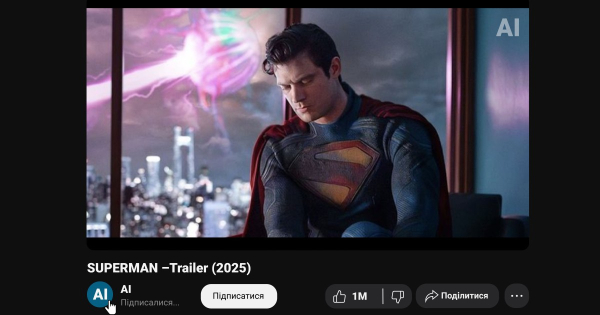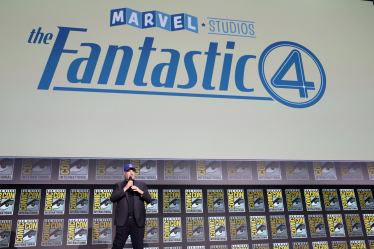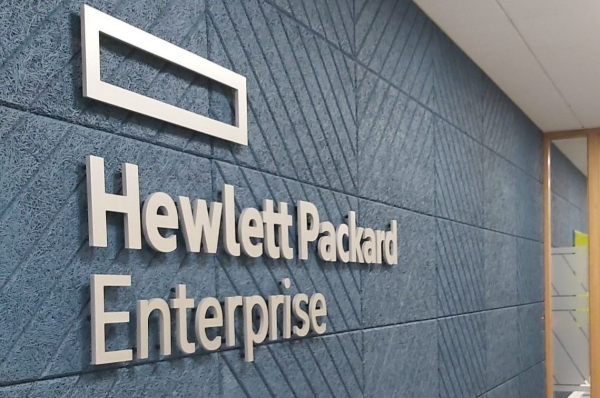
Fake trailers created with the help of artificial intelligence have taken over YouTube and are amassing billions of views, misleading viewers. Studios are profiting from videos that violate their copyrights, instead of blocking them. Forbes Ukraine retells the main points from the analysis of Deadline
A gift for true leaders
Forbes Certificate — 365 days of access to quality analytics, insights, and mind-blowing success stories. Buy Now
Following the release of the official trailer for the film “Superman,” a fake AI-generated trailer has surfaced online. It features clips from the video that aired back in December. And it's just one of thousands of fake trailers that have flooded YouTube in recent years.
Most experts can easily recognize the fakeness of such videos, but for some viewers they are almost indistinguishable from the real thing. In 2024, even French national television made the mistake of showing a fake trailer for “Superman” months before its official release. Director James Gunn responded to it on social media with three vomiting emojis.

Popular Category Richest Date Today “Polish investors offered $4.5 billion for ATB.” First interview with co-owner of the country's largest retailer, Viktor Karachun
Deadline journalists write that they have seen correspondence in which Warner Bros. Discovery claims to have received monetization from fake trailers for “Superman” and the TV series “House of the Dragon”, Sony – from the commercials for “Spider-Man” and “Kraven the Hunter”, and Paramount – from the fake “Gladiator 2”.
Instead of protecting copyright, several Hollywood studios have asked YouTube to direct advertising revenue from views of fake videos to them. It is unclear why they are doing this, nor how much money they are making from such views. All the major studios declined to comment on the situation.
The SAG-AFTRA acting union calls it a “race to the bottom.” “We expect partners to protect intellectual property as aggressively as we protect the rights of our members,” the union said in a statement.
The creators of such videos believe that they help promote the films. Skeptics are convinced that it devalues the official materials and harms the perception of the films themselves. Fake trailers are created for both entertainment and business purposes.

Superman director James Gunn Photo by Getty Images
The history of fakes on YouTube
Users have been posting fake trailers since YouTube was founded in 2005. One of the first viral examples was the fictional sequel to Titanic, in which Jack Dawson, played by actor Leonardo DiCaprio, is found in a block of ice and brought back to life in modern-day New York City to a remix of a Celine Dion song. In 2018, the trailer was updated by Australian YouTuber VJ4rawr2, who is considered one of the “godfathers” of concept trailers. His version, “Titanic 2: Jack's Back,” garnered 53 million views before being banned by 20th Century Fox.
VJ4rawr2, who doesn’t give his real name, started out as an amateur. But in 2015, he quit his job and focused on YouTube, where his videos have amassed 393 million views. He builds trailers around a central joke using editing and AI. His work includes a fictional Mission: Impossible segment in which Tom Cruise flees from New York to Los Angeles, and a trailer in which Macaulay Culkin returns to his Home Alone home to sue his family for childhood injuries.
The fake Bond trailer was even discussed by the specialized film publications Variety and The Hollywood Reporter. A striking example of the professionalization of fake trailers is the Screen Culture channel. It was founded in India by entrepreneur Nikhil P. Chaudhary, who was fond of films since childhood. In 2018, he created the channel, starting with the video “Chandler Bing vs. Sheldon Cooper”. Gradually, his trailers became more and more complex.

Marvel Studios President Kevin Feige at the presentation of the official trailer for Fantastic Four: First Steps. Photo by Getty Images
AI trailers as a way to make money
Chaudhary was initially against using AI, but later realized that he couldn’t compete without it. Unlike VJ4rawr2 or KH Studio (556 million views), which created a trailer with DiCaprio in “The Squidward Tentacles,” Screen Culture focuses on real franchises and sequels. They mix official footage with AI images, creating trailers that look almost like the real thing. A team of 12 editors produces up to 12 videos per week.
Over the past year, Screen Culture has created 23 versions of the Fantastic Four: First Steps trailer. In February, during an anonymous YouTube search, two videos from the channel ranked higher in the results than the official Marvel trailer due to algorithmic advancements. Screen Culture has also created videos for other films using at least six AI tools, including Leonardo, Midjourney, and ElevenLabs.
The channel has been verified by YouTube and now has 1.4 billion views and 1.4 million subscribers. Chaudhary, however, does not disclose his earnings. VJ4rawr2 says he is the first person to take the fan trailer genre seriously and build a team.
Chaudhary's video titles don't include “official” or “concept trailer.” He uses “new” or “first” in the titles. But he clarifies in the description that the video is unofficial, and says it helps the studios.
Studios are responding selectively to violations: About 90% of the 2,700 videos go unpunished, Chaudhary says. In 2023, Warner Bros. Discovery blocked one video of “Furiosa: The Mad Max Saga,” but not others. Amazon sent a letter asking it to remove a fake trailer for “The Boys,” but did not do so in other cases.
Studios are tracking trailer views, hoping that will translate into ticket sales. But publicly, they are watching AI videos, despite loud statements from executives, including The Walt Disney Company CEO Bob Iger, about the need to protect intellectual property. However, the Motion Picture Association declined to comment on the situation with AI trailer monetization.



